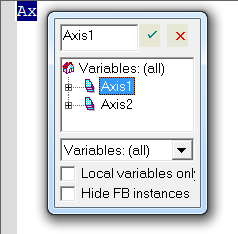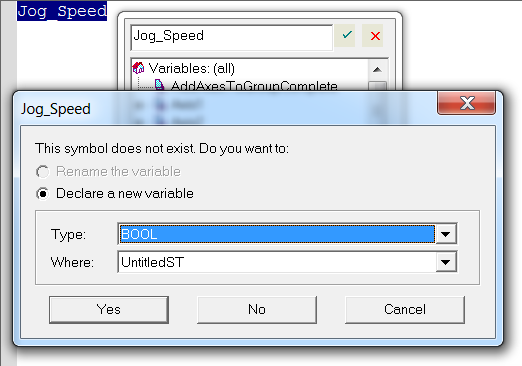Auto-completion of words
 The ST
The ST![]() "Structured text"
A high-level language that is block structured and syntactically resembles Pascal / IL
"Structured text"
A high-level language that is block structured and syntactically resembles Pascal / IL![]() "Instruction list"
This is a low-level language and resembles assembly editor includes powerful commands for automatic completion of typed words, according to declared variables and data types. Pressing Ctrl-space (or alternatively, Ctrl-J) activates the auto-completion.
"Instruction list"
This is a low-level language and resembles assembly editor includes powerful commands for automatic completion of typed words, according to declared variables and data types. Pressing Ctrl-space (or alternatively, Ctrl-J) activates the auto-completion.
If you use auto-complete and there is no match for a variable name in the Dictionary, pressing ENTER will open the variable creation box where you can define a new variable.
The following features are available:
| Auto-completion of: | Action |
|---|---|
| Variable Name | If you enter the first letters of a variable name, you can press CTRL+J to automatically complete the name. A pop-up list is displayed with possible choices if several declared variable names match the typed characters. |
| Missing Symbols | When you press ENTER at the end of a line containing an unknown variable symbol, you are prompted to declare it immediately. |
| FB Member | When you type the name of a function block instance (used either as an instance or a data structure), pressing the point "." after the name of the instance opens a pop-up list with the names of possible members. |
| FB Call |
Type the name of a function block followed by an opening parenthesis MLMstRun(
Press the ENTER key to complete the instructions with the appropriate argument list, including comments and possibly default values so that you are guided through the list of values to be passed to the called function. MLMstRun( (* BlockID : DINT *) , (* Speed : LREAL *) ); |
| ST Block Statement |
On an empty line, enter the main keyword of a ST statement such as "for", "if"... FOR
Press the ENTER key to complete the whole statement, including comments that will guide you through the syntax. FOR (* DINT var *) := (* minimum : DINT *) TO (* maximum : DINT *) BY 1 DO END_FOR; |
Other syntax related commands
When lines are selected, you can automatically indent them. Press TAB or Shift+TAB to shift the lines to the left or right, by adding or removing blank characters on the left.






